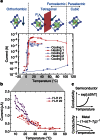Free-electron gas at charged domain walls in insulating BaTiO₃
- PMID: 23651996
- PMCID: PMC3674246
- DOI: 10.1038/ncomms2839
Free-electron gas at charged domain walls in insulating BaTiO₃
Abstract
Hetero interfaces between metal-oxides display pronounced phenomena such as semiconductor-metal transitions, magnetoresistance, the quantum hall effect and superconductivity. Similar effects at compositionally homogeneous interfaces including ferroic domain walls are expected. Unlike hetero interfaces, domain walls can be created, displaced, annihilated and recreated inside a functioning device. Theory predicts the existence of 'strongly' charged domain walls that break polarization continuity, but are stable and conduct steadily through a quasi-two-dimensional electron gas. Here we show this phenomenon experimentally in charged domain walls of the prototypical ferroelectric BaTiO₃. Their steady metallic-type conductivity, 10(9) times that of the parent matrix, evidence the presence of stable degenerate electron gas, thus adding mobility to functional interfaces.
Figures





References
-
- Mathur N. D. et al.. Large low-field magnetoresistance in La0.7Ca0.3MnO3 induced by artificial grain boundaries. Nature 387, 266–268 (1997).
-
- Ohtomo A. & Hwang H. Y. A high-mobility electron gas at the LaAlO3/SrTiO3 heterointerface. Nature 427, 378–380 (2004). - PubMed
-
- Thiel S., Hammerl G., Schmehl A., Schneider C. W. & Mannhart J. Tunable quasi-two-dimensional electron gases in oxide heterostructures. Science 313, 1942–1945 (2006). - PubMed
-
- Chakhalian J. et al.. Magnetism at the interface between ferromagnetic and superconducting oxides. Nat. Phys. 2, 244–248 (2006).
-
- Tsukazaki A. et al.. Quantum hall effect in polar oxide heterostructures. Science 315, 1388–1391 (2007). - PubMed
Publication types
LinkOut - more resources
Full Text Sources
Other Literature Sources

